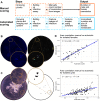A low-cost and open-source solution to automate imaging and analysis of cyst nematode infection assays for Arabidopsis thaliana
- PMID: 36503537
- PMCID: PMC9743603
- DOI: 10.1186/s13007-022-00963-2
A low-cost and open-source solution to automate imaging and analysis of cyst nematode infection assays for Arabidopsis thaliana
Abstract
Background: Cyst nematodes are one of the major groups of plant-parasitic nematode, responsible for considerable crop losses worldwide. Improving genetic resources, and therefore resistant cultivars, is an ongoing focus of many pest management strategies. One of the major bottlenecks in identifying the plant genes that impact the infection, and thus the yield, is phenotyping. The current available screening method is slow, has unidimensional quantification of infection limiting the range of scorable parameters, and does not account for phenotypic variation of the host. The ever-evolving field of computer vision may be the solution for both the above-mentioned issues. To utilise these tools, a specialised imaging platform is required to take consistent images of nematode infection in quick succession.
Results: Here, we describe an open-source, easy to adopt, imaging hardware and trait analysis software method based on a pre-existing nematode infection screening method in axenic culture. A cost-effective, easy-to-build and -use, 3D-printed imaging device was developed to acquire images of the root system of Arabidopsis thaliana infected with the cyst nematode Heterodera schachtii, replacing costly microscopy equipment. Coupling the output of this device to simple analysis scripts allowed the measurement of some key traits such as nematode number and size from collected images, in a semi-automated manner. Additionally, we used this combined solution to quantify an additional trait, root area before infection, and showed both the confounding relationship of this trait on nematode infection and a method to account for it.
Conclusion: Taken together, this manuscript provides a low-cost and open-source method for nematode phenotyping that includes the biologically relevant nematode size as a scorable parameter, and a method to account for phenotypic variation of the host. Together these tools highlight great potential in aiding our understanding of nematode parasitism.
© 2022. The Author(s).
Conflict of interest statement
The authors are not aware of competing interests.
Figures






Similar articles
-
Sublethal fluazaindolizine doses inhibit development of the cyst nematode Heterodera schachtii during sedentary parasitism.Pest Manag Sci. 2021 Jul;77(7):3571-3580. doi: 10.1002/ps.6411. Epub 2021 May 3. Pest Manag Sci. 2021. PMID: 33840151
-
Root endodermal barrier system contributes to defence against plant-parasitic cyst and root-knot nematodes.Plant J. 2019 Oct;100(2):221-236. doi: 10.1111/tpj.14459. Epub 2019 Sep 3. Plant J. 2019. PMID: 31322300
-
Modulation of Arabidopsis Flavonol Biosynthesis Genes by Cyst and Root-Knot Nematodes.Plants (Basel). 2020 Feb 17;9(2):253. doi: 10.3390/plants9020253. Plants (Basel). 2020. PMID: 32079157 Free PMC article.
-
Insect pathogens as biological control agents: Back to the future.J Invertebr Pathol. 2015 Nov;132:1-41. doi: 10.1016/j.jip.2015.07.009. Epub 2015 Jul 27. J Invertebr Pathol. 2015. PMID: 26225455 Review.
-
Soybean cyst nematode detection and management: a review.Plant Methods. 2022 Sep 7;18(1):110. doi: 10.1186/s13007-022-00933-8. Plant Methods. 2022. PMID: 36071455 Free PMC article. Review.
Cited by
-
A Critical Appraisal of DNA Transfer from Plants to Parasitic Cyst Nematodes.Mol Biol Evol. 2024 Feb 1;41(2):msae030. doi: 10.1093/molbev/msae030. Mol Biol Evol. 2024. PMID: 38366574 Free PMC article.
-
A trehalase-derived MAMP triggers LecRK-V-mediated immune responses in Arabidopsis.Sci Adv. 2025 Aug;11(31):eadv8896. doi: 10.1126/sciadv.adv8896. Epub 2025 Jul 30. Sci Adv. 2025. PMID: 40737394 Free PMC article.
-
Plant Parasitic Nematode Identification in Complex Samples with Deep Learning.J Nematol. 2023 Oct 16;55(1):20230045. doi: 10.2478/jofnem-2023-0045. eCollection 2023 Feb. J Nematol. 2023. PMID: 37849469 Free PMC article.
-
A user-friendly software to accurately count and measure cysts from the parasitic nematode Heterodera glycines.Sci Rep. 2025 Feb 6;15(1):4468. doi: 10.1038/s41598-025-88289-6. Sci Rep. 2025. PMID: 39915584 Free PMC article.
References
-
- Sasser JN. A world perspective on nematology: the role of the society. Vistas Nematol. 1987;7–14.
-
- Atkinson HJ, Urwin PE, Hansen E, McPherson MJ. Designs for engineered resistance to root-parasitic nematodes. Trends Biotechnol. 1995;13:369–374. doi: 10.1016/S0167-7799(00)88983-0. - DOI
Grants and funding
LinkOut - more resources
Full Text Sources

